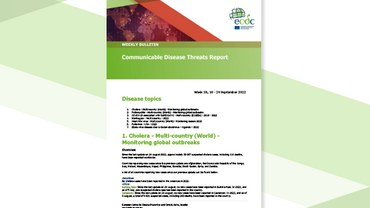External quality assessment for influenza antiviral susceptibility for the European Reference Laboratory Network for Human Influenza
This report presents the results of the influenza virus antiviral (AV) susceptibility external quality assessment (EQA) which was held for European reference laboratories. This is the second AV EQA panel distributed by the European Reference Laboratory Network for Human Influenza (ERLI-Net) since 2008.
Executive summary
During autumn 2013, an influenza virus antiviral (AV) susceptibility external quality assessment (EQA) was held for European reference laboratories. This was the second AV EQA panel distributed by the European Reference Laboratory Network for Human Influenza (ERLI-Net), and its predecessor organisation, since the European Influenza Surveillance Network (EISN) was established in 2008. The objectives of the exercise were to both provide participants with an independent mechanism to check performance and to provide information at the level of the whole network as to capacity and capability for phenotypic and/or genotypic AV testing and accurate reporting into The European Surveillance System (TESSy).
Twenty-five laboratories from 20 European countries participated in the exercise while 11 laboratories opted out as they did not perform assays capable of determining antiviral susceptibility, representing 69% of the network laboratories. Each participant received a panel of seven coded samples containing recent influenza viruses with substitutions known to confer reduced or highly reduced inhibition by neuraminidase inhibitor class of antiviral drugs. Participants tested the viruses using the antiviral susceptibility testing methodology currently used in their laboratories.
Twenty-four of the 25 (96%) laboratories participating in the EQA undertook genetic characterisation. Depending on the laboratory and the sample involved, techniques varied from pyrosequencing, single nucleotide polymorphism PCR’s to direct sequencing of the neuraminidase gene. As a consequence, the interpretation that could be made about the antiviral susceptibility of the virus varied based on the technique used. In light of issues identified through the routine reporting of antiviral susceptibility data to TESSy, strict marking criteria were applied to the interpretation of genotypic results. Despite this, all 24 participating laboratories returned results for the three influenza A(H1N1)pdm09 samples, with 82% correctly interpreting results for oseltamivir and 78% correctly interpreting results for zanamivir susceptibility. A detailed assessment of interpretive issues identified will inform future training.
Seventeen of the laboratories (68%) returned phenotypic results. Of these, 14 (82%) of the laboratories reported no errors in any of the samples, while the remaining three laboratories accounted for four incorrect results. A mixed sample consisting of two influenza A(H1N1)pdm09 viruses, one with normal inhibition and one with highly reduced inhibition, accounted for three of the four incorrect answers.
Overall results for the exercise were broadly encouraging. There was an increase in the number of laboratories using phenotypic testing and an improvement in the average score achieved with this technique compared to the previous panel (97% compared to 92% in 2010). The proficiency for genotypic testing also improved, highlighted by the detection of amino acid substitution previously associated with highly reduced inhibition (AAHRI) from within a mixed sample also containing sequences with no amino acid substitutions previously associated with highly reduced inhibition (AANI). There were 87.5% of laboratories identifying the AAHRI genotype in this sample compared with 79% in 2010. This underlines the general improvement in the technical ability of network laboratories and suggests that interpretation and reporting of genotypic results is the area where training and support should now be targeted.




